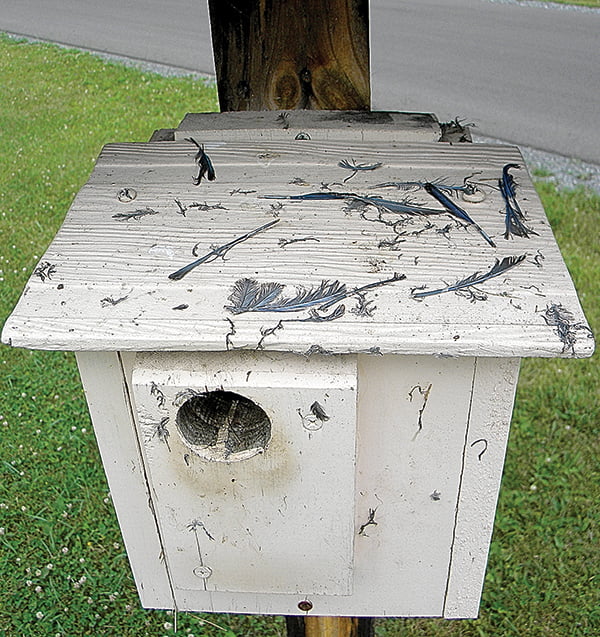
Dave Curry
Contributing Writer
Once again, as the end of the year rolls around, it is time to look at the annual Bluebird Report. This completes the 11th year of observations of about 20 birdhouses located mostly around and near the Green Bank Observatory.
These bird boxes – all with 1.5-inch openings – are strategically placed to appeal to the native cavity nesters; primarily Bluebirds, Tree Swallows and the occasional House Wren. Other species such as Nuthatches and Chickadees have rarely nested in them, but the invasive, non-natives such as House Sparrows have generally been discouraged.
The summer of 2017 was overall a good one for Bluebirds. There were 16 nesting attempts, 13 of which were successful by fledging at least one or more young birds. A total of 50 young blues entered the great outdoors, matching the hatch from 2015 but bettering the 2016 total of 37. The summer of 2013 was also a good year producing 47 young bluebirds, so maybe it’s just an every other year thing.
The season began on time in late April with a near record start of 10 attempts, but second nestings were below par in late June and July. The hot, dry weather of that time may have been great for farmers making their first cutting of hay but it was a setback for Bluebird families. Though the second attempts were down somewhat, all were successful.
Predators, blow flies and other environmental factors were about normal. Of the three failed nesting attempts, two were in the same bird box. For the first one, the four young were found starved to death at about 14 days after hatch. A filthy nest indicates that something happened to the parent bird as Blues would never allow a nest to get dirty. Later a family of Sparrow Hawks was seen flying nearby, probably the culprits in the parents’ disappearance.
Almost immediately another pair of Blues moved into the same box. They hatched out a family of four that made it to day 10 – it usually takes 17-to-18 days to reach fledging – then they suddenly disappeared. A little bit of sleuthing showed us a clean nest, but a box covered with sticky feathers and spots of blood on the outside. Even Sherlock Holmes would deduce that Mr. Raccoon had paid a visit for a midnight snack. Such are the ways of the natural world.
Incredibly enough, a third pair of Blues moved into the house and was successful in raising three late young.
The Tree Swallows also had a good year with nine out of 12 nesting attempts being successful and producing at total of 36 young.
Only 16 birds fledged in 2016 with an over-abundance of fly larvae impacting all the hatching birds that year.
Every year is a learning experience and one can’t help but learn something new.
One day while examining a family of five-day-old wrens, large blister-like structures were observed on the leading edge of their tiny little wings. Upon touching, the “blisters” began to move. Further touching caused more movement ending with a large fly larva exiting/ backing out of the pin feather. Altogether, more than 30 maggots were removed from the seven young birds. The nest was then cleaned and rebuilt with new weeds to get rid of other fly larvae and young were reinstalled. Next check a week later showed all the young feathered and healthy and ready to go.
Sometimes an intervention can help.
Meanwhile the wastewater treatment ponds were having a good year with the Wood Ducks.
Four or five Woodie hens hatched their young out in tree cavities in the forest then marched them in to the ponds as happens every year. The young are then badly predated by hawks and crows to the point that only two or three fledged from the original 50 or so ducklings in 2016.
The summer of 2017 was a different story, possibly because a family of Canadian Geese also showed up. For the first time in several years, a pair with three young goslings marched in to make the ponds home. They seemed to ignore the Wood Ducks but probably intimidated the crows that usually hung around waiting to catch and kill a young duckling for lunch. Consequently, about 15 ducks appeared to reach fledging and were able to fly out with the first batch of migrating woodies in the fall.
Thanks to the GBO for allowing me to indulge a rather unusual hobby.
Dave Curry is a (somewhat) retired telescope operator. He may be contacted at dlcurry@frontiernet.net


